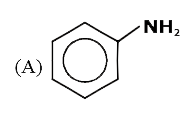Most reactive for nitration is
Benzene
Nitrobenzene
Benzaldehyde
Phenol
The correct Answer is:D
To determine which compound is most reactive for nitration among benzene, nitrobenzene, benzaldehyde, and phenol, we need to analyze the electron-donating or electron-withdrawing effects of each compound.
1. Identify the Compounds: The compounds we are considering are:
- Benzene
- Nitrobenzene
- Benzaldehyde
- Phenol
2. Understand Nitration: Nitration is an electrophilic aromatic substitution reaction where a nitro group (NO2) is introduced into an aromatic ring. The reactivity of the aromatic compound towards nitration depends on the electron density of the ring.
3. Analyze Benzene:
- Benzene has a neutral electron density. It can undergo nitration, but it does not have any electron-donating or withdrawing groups that would significantly affect its reactivity.
4. Analyze Nitrobenzene:
- Nitrobenzene contains a nitro group (NO2), which is an electron-withdrawing group. This decreases the electron density on the benzene ring, making it less reactive towards electrophilic substitution reactions like nitration.
5. Analyze Benzaldehyde:
- Benzaldehyde contains a carbonyl group (C=O), which is also an electron-withdrawing group. Like nitrobenzene, it reduces the electron density on the benzene ring, leading to decreased reactivity in nitration.
6. Analyze Phenol:
- Phenol has a hydroxyl group (–OH), which is an electron-donating group through resonance. This increases the electron density on the benzene ring, making phenol more reactive towards electrophilic nitration compared to benzene.
7. Compare Reactivity:
- Based on the analysis:
- Nitrobenzene < Benzaldehyde < Benzene < Phenol
- Therefore, phenol has the highest reactivity for nitration due to the increased electron density on the aromatic ring.
8. Conclusion: The most reactive compound for nitration among the given options is Phenol.
- Benzene
- Nitrobenzene
- Benzaldehyde
- Phenol
- Benzene has a neutral electron density. It can undergo nitration, but it does not have any electron-donating or withdrawing groups that would significantly affect its reactivity.
- Nitrobenzene contains a nitro group (NO2), which is an electron-withdrawing group. This decreases the electron density on the benzene ring, making it less reactive towards electrophilic substitution reactions like nitration.
- Benzaldehyde contains a carbonyl group (C=O), which is also an electron-withdrawing group. Like nitrobenzene, it reduces the electron density on the benzene ring, leading to decreased reactivity in nitration.
- Phenol has a hydroxyl group (–OH), which is an electron-donating group through resonance. This increases the electron density on the benzene ring, making phenol more reactive towards electrophilic nitration compared to benzene.
- Based on the analysis:
- Nitrobenzene < Benzaldehyde < Benzene < Phenol
- Therefore, phenol has the highest reactivity for nitration due to the increased electron density on the aromatic ring.
Similar Questions
Knowledge Check
Most reactive towards nitration reaction (Substitu- tion electrophilic aromatic)
A B
B C
C D
D
Which of the following compounds is the most reactive towards nitration with a mixture of conc. HNO3 and conc. H2SO4 under identical conditions?
AC6H6BC6H5NO2CC6H5CH3DC6H5Cl3The order of decreasing reactivity towards nitration in the following compound is :
 AII>IV>III>IBII>I>III>IVCIII>II>I>IVDI>IV>III>II
AII>IV>III>IBII>I>III>IVCIII>II>I>IVDI>IV>III>II
Arrange the following in order of their reactivity towords nitration

View SolutionWhich of the following is most reactive for hydrolysis?
View SolutionWhich of the following is the most reactive towards ring nitration ?
View SolutionThe most reactive hydrocarbon is
View SolutionThe most reactive hydrocarbon is
View Solution